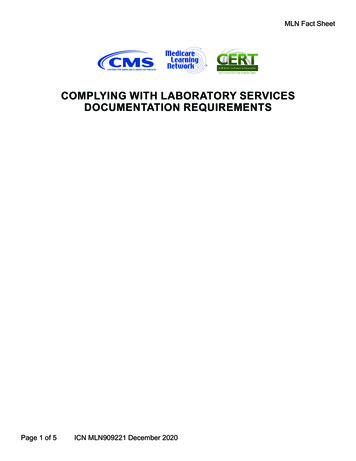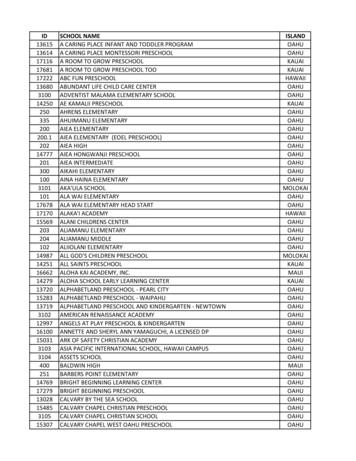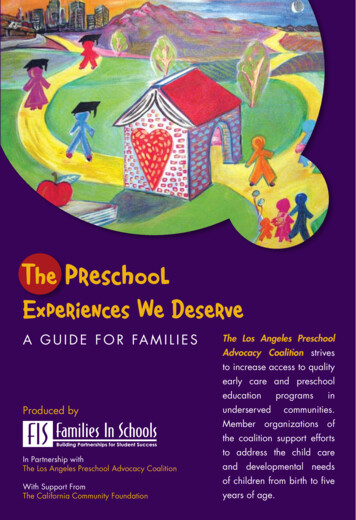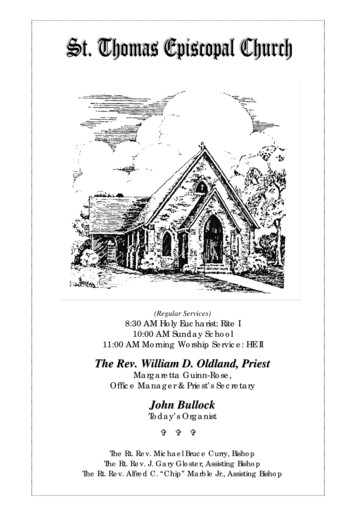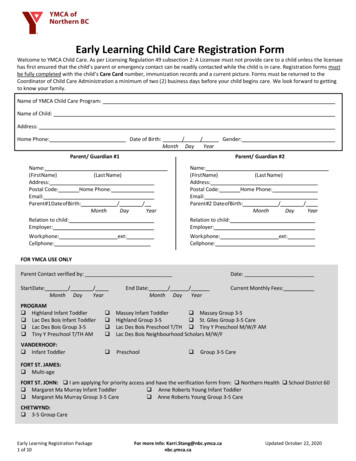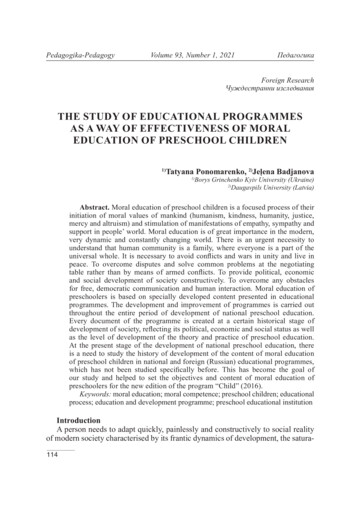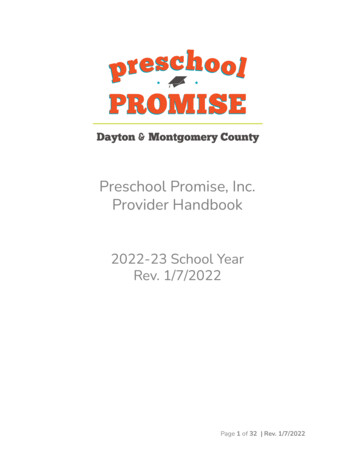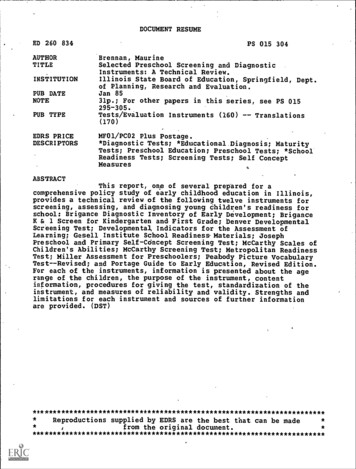
Transcription
DOCUMENT RESUMEED 260 834AUTHORTITLEPS 015 304PUB DATENOTEBrennan, MaurineSelected Preschool Screening and DiagnosticInstruments: A Technical Review.Illinois State Board of Education, Springfield, Dept.of Planning, Research and Evaluation.Jan 8531p.; For other papers in this series, see PS 015PUB TYPETests/Evaluation Instruments (160) -- TranslationsINSTITUTION295-305.(170)EDRS PRICEDESCRIPTORSMF01/PCO2 Plus Postage.*Diagnostic Tests; *Educational. Diagnosis; MaturityTests; Preschool Education; Preschool Tests; *SchoolReadiness Tests; Screening Tests; Self ConceptMeasuresABSTRACTThis report, one of several prepared for acomprehensive policy study of early childhood education in Illinois,provides a technical review of the following twelve instruments forscreening, assessing, and diagnosing young children's readiness forschool: Brigance Diagnostic Inventory of Early Development; BriganceK & 1 Screen for Kindergarten and First Grade; Denver DevelopmentalScreening Test; Developmental Indicators for the Assessment ofLearning; Gesell Institute School Readiness-Materials; JosephPreschool and Primary Self-Concept Screening Test; McCarthy Scales ofChildren's Abilities; McCarthy Screening Test; Metropolitan ReadinessTest; Miller Assessment for Preschoolers; Peabody Picture VocabularyTest--Revised; and Portage Guide to Early Education, Revised Edition.For each of the instruments, information is presented about the agerange of the children, the purpose of the instrument, contentinformation, procedures for giving the test, standardization of theinstrument, and measures of reliability and validity. Strengths andlimitations for each instrument and sources of further informationare provided. **************************Reproductions supplied by EDRS are the best that can be madefrom the original *******************************
roU.S. DEPARTMENT OF EDUCATIONNATIONAL INSTITUTE OF EDUCATICNEDUCATIONAL RESOURCES INFORMATIONCENTER IERICI)(This document has been reproduodasreceived from the person or organizationoriginating it.0 Minor changes haw been made to improveroproductien quality.Points of view or opinions au tod in this documint do not necessarily rePresentoff icial NIEpocition co policy.SELECTED PRESCHOOL SCREENING AND DIAGNOSTIC INSTRUMENTS-- A TECHNICAL REVIEW --ILLINOIS STATE BOARD OF EDUCATION"PERMISSION TO REPRODUCE THISMATERIAL HAS BEEN GRANTED BYSOAk3-.TO THE EDUCATIONAL RESOURCESINFORMATION CENTER (ERIC)."(:)Cil)CIOWalter W. Naumer, Jr., ChairmanState Board of EducationTed SandersState Superintendent of EducationDepartment of Planning, Reiearch and EvaluationPstiSpringfield, IllinoisJanuary, 1985
FOREWORDThe purpose of this report is to provide a technical review of twelvescreening and diagnostic instruments which are used in screening, assessing,or diagnosing young children's readiness for school.For each of theinstruments, information is presented concerning the purpose of theinstrument, age-range of children, the procedures for standardtzation of theinstruments, and measures of reliability and validity. Further, thestrengths and limitations for each instrument are provided. Last,information sources are identified. This report was prepared for the StateBoard of Education policy study on early childhood education by MaurineBrennan. The interpretations and conclusions expressed herein do notnecessarily reflect the position or policy of the State Board of Education.Ted SandersState Superintendent of Education3
TABLE OF CONTENTSPageBrigance Diagnostic Inventory of Early DevelopmentThe Brigance K & 1 - Screen for Kindergarten and First Grade .1.-.3Denver Developmental Screening Test5Developmental Indicators for the Assessment of Learning7()-Gessel 1 Institute School -Readiness Materials9Joseph Pre-School and Primary Self-Concept Screening Test11McCarthy ,Scales of Children's Abilities13McCarthy-Readingness Test16Metropolitan Readiness Test19Miller Assessment for Preschoolers21Peabody Picture Vocabulary Test - Revised24The Portage Guide to Early Education, Revised Edition26
Brigance Diagnostic Inventory of Early Development.Author:Albert H. BrigancePublisher:Curriculum Associates, Inc.6 Henshaw StreetWoburn, MA 01801Date:1978Cost:About 50.00Age Range:0-7 YearsPurpose:The Inventory is 1) an assessment instrument, 2) aninstructional guide, 3) a record-keeping tracking system,4) a tool for developing and communicating an IndividualEducation Plan and, finally, 5) a resource for trainingparents and professionals in child growth and development.Description:Included in the Inventory are hoth assessment guides andinstructional objectives for:Pre-Ambulatory Motor Skills and BehaviorsGross Motor Skills and BehaviorsFine Motor Skills and BehaviorsSelf-Help SkillsPre-Speech AbilitiesSpeech and Language SkillsGeneral Knowledge and ComprehensionReadihessBasic Reading SkillsManuscript WritingMath SkillsA variety of assessment procedures can be used: parent.interview, observation scales and the child's performanceon structured tests. The Inventory is informal,criterion-referenced, and individually administered byteacher, specialist, or trained paraprofessional. Theexamingr selects the skills that are appropriate for eachchild, depending on age and purpose of testing.Standardization:Standardization procedures are not available. TheInventory was field-tested in a wide variety of programsin 16 states.Reliability:Not available (1980)Validity:Inspection of the content of the inventories indicatescomprehensive coverage, careful preparation, andmeticulous selection of items (Salvia & Ysseldyke,1981).Thus, content validity is evidenced.15
DiscussionStrengths:The Inventory is a comprehensive instrument assessing awide range of skills for both the infant and thepreschooler. Many skills not usually assessed areincluded, such as use of wheel toys, brush painting, andknowledge of weather and time concepts. The inclusion ofinstructional objectives also increases the usefulness ofthe instrument for teachers who need to plan IndividualEducational Plans. The built-in recordkeeping system ishelpful.The nature of the tool allows such variety in assessmentprocedures that it can be used with older gh extensive field testing was done, no reliabilityor validity data are available (1980).Compton, Carolyn. A Guide to 65 Tests for SpecialEducation. Belmont, California:Pittman Learning, 1980.Salvia, John and Ysseldyke, James E. Assessment inSpecial and Remedial Education, Second Edition. Boston:Houghton - Mifflin, 1981.2
The Brigance K & 1 - Screen for Kindergarten and 1st GradesAuthor:Albert H. BrigancePublisher:Curriculum Associates, Inc.5 Esquire RoadNorth Bitlerica, MA 01862Date:1983Cost:UnknownAge Range:Kindergarten and First GradePurpose:The purpose of the Brigance K & 1 Screen is to identifyyoungsters who may need further evaluation to see ifspecial services are necessary.Subsequent instructionmay be designed either to deal with learning difficultiesor to provide extra stimulus for capable individuals.Description:The Brigance K & 1 Screen is a compilation of subtestsfor measuring the individual performance of kindergarten& first grade children. All but the picture vocabularyassessment were excerpted or adopted from the morecomprehensive Brigance Diagnostic Inventory of EarlyDevelopment (0-7 years) (1979), and the BriganceDiagnostic Inventory of Basic Skills (K-6th grade) (1976).There are 18 subtests of which five are solely forkindergarteners and six, solely for 1st graders. Sevensubtests are for both age levpls. These include personaldata response (child provides orally his or her firstname, last name, age, address, birthdate), colorrecognition (ten colors), picture vocabulary (child namesobjects in ten drawings), visual motor skills (childcopies five shapes), rote counting (child counts to ten),numeral comprehension (chil associates quantities with !numerals), and personal daprinting (child's name).%In addition to the basic assessments, five advanced tasksare provided for individuals who score aboVe 95% on thebasic battery.The Brigance screen also provides checklists for theexaminer, teacher and parents: The examiner'sobservation checklist is for noting behaviors thatreflect possible'difficulties in the child's visual,auditory, speech, affective, motor and physicalperformances or conditions.Reliability andValidity:No information on statistical reliability or validity isprovided.To judge from the similarity between theBrigance Screen assessment and other measures (i.e.,3-
Metropolitan Readiness Tests) and from the opinion ofmany professiomls in the field of testing, thisscreening battery has appropriate content validity,however.Conclusion:The Brigance Screen has the potential for being a goodscreening instrument because of its straight-forwardformat, its organization, and its content.No specialtraining is required and the Brigance Screen can usuallybe given in about 10 minutes.Source:Helfeldt, John P. "The Brigance K & 1 Screen forKindergarten and First Grade." The Reading Teacher, May1984.-4
Denver Developmental Screening Test (DDST)Authors:William K. FrankenburgJoseph B. DoddsPublisher:LADOCA Project & Publishing FoundationEast 51st Avenue and Lincoln StreetDenver, CO 80216Date:1967, 1970Cost:Approximately 10 for Test tit, Reference Manual and 25test forms.Age Range:1 month to 6 years2E1919.:To detect significant motor, social and/or languagedelays through a series of developmental tasks.Description:The Denver consists of 105 items that are grouped in 4sections:Personal-Social (ability to get along with othersand look after oneself)Fine-Motor-Adaptive'(ability to use hand to pick upobjects and draw)Language (hearing, following directions, speaking)Gross Motor (sitting, walking, jumping)On the one-page score sheet, an age range for expectedperformance is shown for each item. Initially, onlytasks specific to child's chronological age (about 20items).are administered. These are scored on the form aspass, fail, or questionable and taken together give aprofile of the child's performance.Details are given ofthe exact age at which 25%, 50%, 75%, and 90% of thestandardization sample could "pass" each of the 105items.Final results are categorized as "normal,""abnormal," or "questionable."During the administration, the mother is present, whenpossible, and some items can be based on her report, butdirect observation by the. examiner should be usedwhenever possible.Standardization:The Denver was standardized on 1036 children, 543 malesand 493 females, between the ages of two weeks and 6.4years. The sample was controlled for ethnic andoccupational status according to the 1960 census from theCity of Denver. No premature, handicapped, or adoptedchildren were used in the sample.
Reliability:The reliability studies have produced test - retestcorrelations ranging from a low of .66 to a high of .93depending on the child's age. Some items are more stablethan others; most of these items (63%) are the onesrequiring the mother to report.Validity:In a preliminary study, the Denver correlated highly(.97) with the Yale Developmental Examination. Validitystudies showed that paraprofessionals using the Denvercorrectly identified abnormal children 92% of the time.-DiscussionStrengths:The Denver is a widely used screening measure designed tobe used by trained paraprofessionals. The test manual iswell written and the test materials are easy toadminister and inexpensive.Limitations:The norm group contains a significantly higher proportionof white children and children whose fathers,are in theprofessional, managerial, or sales occupations than thecensus distribution would warrant.Its use under the age of 30 months should be discouragedsince it is of questionable reliability in the first twoyears of life and misses a higher proportion of childrenidentified by technically more superior tests (Bayley andCartell).In a validity study when the Denver was correlated withthe Revised Yale Develo mental Schedule, there was aconsiderable over-se ection of normal c ildren in thethird year of life: 42 percent of normal children on theRevised Yale were called abnormal on the Denver.Sources:The Denver appears to be a fairly satisfacfory screeningtool at 4 - 4 1/2 years of age, but even here itsconcurrent validity is lower than that of other screeningtests, such as the Peabody Picture Vocabulary Test.Barnes, Keith E. Preschool Screeninand Prediction of C ildren at Risk.Charles C. Thomas 1982.:The Measurementpring e d, IL:Johnson, H. Wayne. Preschool Test Description,Springfield, IL: Charles C. Thomas, 1979.Moriarty, Alice E. in Buros, O.K. (Ed.) The SeventhUniversity ofMental Measurement Yearbook. Lincoln, NB:Nebraska, Buros Institute of Mental Measurements, 1972,405.Southworth, Lois E.; Burr, Rosemary L.; and Cox, AndrenEwell.Screening and Evaluating the Young Child,Springfield, IL:Charles C. Thomas, 1980.-6- 0
Developmental Indicators for the Assessment of Learning (DIAL)Authors:PubliAerCarol Mardell and Dorothea Goldenberg,DIAL, Inc.Boi 911Highland Par(k, IL60035)tiDate:973Cost: 125 for Dial Assessment Kit and 13 for a set of parentcar'ds.Age Range:2.6 to 5.6 yearsPurpose:To identify children' in need of follow-up service becauseof learning problems.Description:DIAL is a multidimensional screening test that requiresan approach whereby four stations are set up to screenfor the following areas of functio:ing: Gross Motor,Fine Motor, Concept, Communications.Four examiners, who function as a team, can be teachers,parent volunteers, or paraprofessionals who are trained ,to administer the DIAL. The coordinator or team leadershould be a professional in special education, earlychildhood, psychology, speech and language,' or relatedfields.Its administration requires 20 to 30 minutes perSix to eight'chiTdren can, be tested in an hour.child.The examiner at each station also notes his/hersubjective impressions df 12 behaviors. Cards, which maybe given to parents, contain suggested enrichment orremedial experience that parents may provide at home.Standardization& Norms:Reliability:In 1983, norms were reconstituted by randomly sampling100 subjects from each month of age from 36 to 66. months(1550 males and 1550 females) from the 1972 subjectpool.While controlling for age and sex'3 the revisednorms may still over-represent rural subjects, black,subjects, and subjects from low SES.That is, theirrepresentation in the, sample is disproportionate to thenumbers of these grbunin'the general popdlation. Also,a greater geographic- representation (outside of Illinois)wduld have allowedmore Confidence in the norms.Inter-rater reliability (.81 to .99) was determined byhaving 16 examiners scoreAdeotapes-of eight children.For 520 children tested in 1972 and retested in 1983,correlations were from .43 to .67. Given the fact thatmany of the test items are measuring developmentalfunction susceptible to changes with. chronological age,this finding is quite respectable (Barnes, 198,2).0
a.Validity:The correlation coefficient between the DIAL and thePeabody Picture Vocabulary Test was .60; between the DIALand the Stanford-Binet it was .74.In a 1976 study, 249 children were tested with the DIALand the Metropolitan Readiness Tests, the Iowa Test ofBasic Skills, the Metropolitan Achievement Test, theStanford Achievement Test and a teacher rating scale ofsocial-affective behaviors. The multiple'correlationsbetween DIAL scores and these measures ranged from .47 to.60, all ;statistically significant.Concurrent validity (.92) was found in a study of 12children assessed on. DIAL and reassessed by a diagnosticteam of psychologists, social workers, nurses, andelementary education counselors.Discussion:"DIAL is intended for screening groups of children inpreschool programs to identify those with serious delaysin need of further assessment. The cutoff points are setto identify the lowest 10%. Middle-class or other groupswith extensive nursery school experience rarely fallbelow cutoff, but they may well have significant learningdisabilities that will show up in an academicallyoriented kindergarten. The DIAL should be considered agross screening instrument - not one that will identifythe child with marginal disabilities." (Compton, 1980)Sources:Barnes, Keith E. Preschool Screening: The Measurementand Prediction of Children At-Risk. Springfield,Charles C. Thomas, 1982.Compton, Carolyn. A Guide to 65 Tests for SpecialEducation.Belmont, CA: Pittman Learning, 1980.'Illinois State Board of Education. Handbook forPreschool Screening in Illinois, March 1981.McCarthy, James J. in Buros, 0. K. (Ed.) The,EighthMental Measurement Yearbook.Lincoln, NB: University ofNEFk73T13TrOriinTC---teos.rf Menial Measurement, 1978,428.Salvia, John and Ysseldyke, James E. Assessment inSpecial and Remedial Education, Second Edition. Boston:Houghton-Mifflin, 1981.Southworth, Lois E.; Burr, Rosemary L.; and Cox, AndreaEwell.Screening and Evaluating the Young Child.Springfield, Illinois: Charles C. Thomas, 1980.Werner, Emmy E. in Buros, 0. K. (Ed.) The Seventh MentalMeasurement Yearbook.Lincoln, NB: University ofNebraska, Buros Institute of Mental Measurements, 1972,405.-8-12
Gessell Institute School Readiness MaterialsAuthors:Fraaces L. Ilg and Louise Bates AmesPublisher:Programs for Education, Inc.Western Psychological Services12031 Wilshire Blvd.'Los Angeles, CA 90025 (distributer for manual and kit)Copyright Dates:1965, 1980Cost:School Readiness Screening Test-- 87.00 for developmentalkit, school readiness textbook, recording sheets for 50children. School Readiness Test Complete Battery-- 91.00for developmental kit, school readiness textbook,recording sheets for 50 children.Age Range:School Readiness Screening Test 4 1/2 - 5School Readiness Test Complete Battery 4 1/2 - 9Purpose:Screening determination of school readiness on the basisof developmental age, rather than chronological age or IQ.Description:Screening Test includes cube test, interview questions,writing namej writing numbers, copying forms, incompleteman test, naming animals, home, and school-preferences,;----.Complete Battery includes the same tests as the ScreeningTest plus right and left subtests (naming body parts,single commands, double commands, verbal and motorresponse to right and left pictures), matching forms,memory for designs, visual projective test.The tests are administered individually by a persontrained by the Gessell Institute. The Screening Testtakes about 20 minutes; the Complete Battery about 40minutes. The results of.the tests are expressed indevelopmental ages.Standardization:50 boys and 50 girls from North Haven Connecticut at eachof seven age levels including 5.5 controlling for SES.Rel iabil it,y.:However, in an initial study ofNot formally developed.100 kindergarten children, the investigators' globaljudgments as to readinbss were in close agreement withglobal teacher judgments, and also were highly related to(Buros)academic section assignment 6 years later.Validity:In a study done in 1980-81,Not formally developed.Wood, Powell and Knight examined the predictive validityTestof the Gessell School Readiness Screening Test.results obtained by certified examiners of 84kindergarten-age children were compared with subsequent-9-
school success or "special needs" designations. Thestudy suggested that the Gessell developmental screeningprocedure which results in a developmental age iseffective for predicting success or failure inkindergarten."Furthermore, it demonstrates that thechronological age of children entering kindergartenwithin the range of 4 to 6 years is unrelated-to eventualsuccess or failure. Correct developmental placementwould result in between one-third to one-half of allchronologically eligible kindergarten students beingrecommended as developmentally unready for kindergarten.The exact critical age for recommending placement inkindergarten should be calculated locally because averagedevelopmental ages of children as well as thedevelopmental level of kindergarten curricula vary acrossschool districts." (Woods et al., 1984).Sources:Buros, O.K. (Ed.) The Seventh Mental MeasurementYearbook.Lincoln, NB: University of Nebraska BurosInstitute of Mental Measure, 1972, 750.Johnson,'H. Wayne. Preschool Test Descriptions.Springfield, IL:Charles C. Thomas, 1979.Wood, Chip; Powell, Sarah; and Knight, Chris."Predicting School Readiness: The Validity ofDevelopmental-Age," Journal of Learnin Disabilities17(1) (January, 1988.:- 10 -14
Joseph Pre-School and Primary-Self-Concept Screening TestAuthor:Jack JosephPublisher:Stoelting1350 South Kostner AvenueChicago, Illinois 60623Date:1979Cost: 56.00 for manual, 56 stimulus cards, 100 identityreference drawings, 100 record forms.Age Range:3.6 to 9.11 yearsPurpose:The Joseph Pre-School and Primary Self-Concept Test wasdeveloped to objectively screen and identify children atthe preschool and primary levels, who, due to negativeself - appraisals may experience learning problems ordevelop other adjustment difficulties.Description:The test is individually administered. The child drawshis own face on a figure of the same sex with a totallyblank head area. He is then required to respond to aseries of 15 questions, 13 of which are illustrated bydichotomous, sets of pictures, and indicates the one withwhich he identifies more closely. The 15 questions are--objectfvely-scored, -and -the-face-drawing-ts-qualitativelyevaluated.A global self-concept score is computed by summing theThese scores aresubject's score across the 15 items.interpreted in light of five levels of self-conceptclassification: high positive, moderate positive, watchlist, poor, and high-risk negative.Scores for children whose responses place them in thepoor or high-risk negative categories may be analyzedfurther using the Diagnostic Dimensional Evaluation.This procedure associates each-item with five constructsdetermined by the test author to be related toself-concept: Significance, and its derivative, Virtue;Competence, and its derivative, Power; and GeneralEvaluative Contentment.A final rating can be provided by an independentobserver's evaluating the subject's self-concept on a(Telzrow).10-point scale.Standardization:The standardization sample of 1245 children in urban,rural and suburban regions of Illinois was 91% white, and9% black and other minorities. Each of the threenormative age groups (3.6 to 4.6, 4.7 to 5.11, and 6.0 to9.11) included approximately 8% handicapped children.
Reliability:coefficient of .87 was seen onA test-retest reliabilitysampleof 18 preschoolersthe Joseph for a limited(median age of 4.0) with a four-week interval betweenadministrations.ranged fromInternal consistency reliability coefficients.59 to .81 with a media correlation of .73.Validity:Construct validity for the Joseph was established bycorrelating Global Self-Concept Scores with scoresderived from two self-concept rating scales that werecompleted by teachers.Scores from the Inferred Self-Concept Judgment Scale werecorrelated to Joseph Global scores for a group of 25.51 at .01 level ofpreschoolers. The correlation wassignificance.differentScores from the Behavior Rating Form for fourgroups of children were correlated with Joseph scores.All of the correlations were significant.Joseph scores in the poor or high-risk negativeachievementcategories correctly identified poor academicand 70% offour years later for 83% of preschool childrenkindergarteners, which was significant at the .0001 levelvalidity.(Joseph, in preparation) 'Ms showing The test materials are generally well-designed-and easythorough and reportsto administer. The manual is veryIt seems tofavorable reliability and validity results.be a useful screening tool for social-emotionaldisabilities in young children.The test user should be aware of the potentiallythose thatthreatening nature of some of the items (e.g.,siblingask whether a parent likes the subject or athatItisrecommendedparents.better) especially forsuchatestthe nature of the items and the purpose forthe testbe explained thoroughly to parents prior toadministration.JosephJoseph, J. A Predictive Validity Study of theTest, inSelf-ConceptScreeningPre-School and Primarypreparation.Cox, AndreaSouthworth, Lois E., Burr, Rosemary L.; andtheYoungChild.Screening and EvaluatingEwell.Charles C. Thomas, 1980.Springfield, Illinois:"Joseph Pre-School and PrimaryTelzrow, Cathy Fultz.to theSelf-Concept Screening Test" (review) submittedpublication ofinclusioninthenextBuros Institute forTests in Print.
McCarthy Scales of Children's Abilities (MSCA)Author:Dorothea McCarthyPublisher:The Psychological Corporation757 Third AvenueNew York, New York 10017Date:1972Cost: 70.00 for complete set, which includes equipment,manual, 25 record forms, 25 drawing booklets and carryingcase.Age Range:2.5 to 8.5 yearsPurpose:It is designed to proVide both a diagnostic profile ofabilities and a summary score comparable to the standarddeviation IQ.Description:The Scales are administered individually by apsychologist, learning disabilities specialist or otherprofessionals well trained in individual testing.TheMcCarthy is made up of 6 scales as follows:I.VerbalPictorial MemoryWord KnowledgeVerbal MemoryVerbal FluencyOpposite AnalogiesIII. Quantitative ScaleNumber QuestionsNumerical MemoryCounting and SortingV.Memorial ScalePictorial MemoryTapping SequenceVerbal MemoryNumerical MemoryII. Perceptual-PerformanceScaleBlock BuildingPuzzle SolvingTapping SequenceRight Left-Orienta tion (age 5 andabove)Draw-A-DesignDraw-A-ChildConceptual GroupingIV.General CognitiveScale: Composedof all of the testsin the verbal,perceptualperformance andquantitative scales.VI. Motor ScaleLeg CoordinationArm CoordinationThe time for administering is from 45-60 minutes.-13-
Standardization:The standardization sample included 1032 children with atleast 100 in each half -year age grouping from 2 1/2 to8 1/2 years. The nationwide sample reflected the U.S.population at the 1970 census for race, geographicregion, and father's occupation.The sample includedequal numbers of each sex and excluded children withmarked handicaps and bilingual children with limitedcomprehension of English.Reliability:Split-half reliability for the General Cognitive Indexaveraged .93 within age levels; average coefficients forthe other five scales ranged from .79 to .88. Retestreliabilities over a one-month interval for 125 childrenclassified into 3 age groups averaged .90 for GeneralCognitive Index (GCI) and ranged from .69 to .89 for theseparate scales.The Motor Scale is least reliable at the older age of thetest.Validity:Thirty-six six year -olds were tested during a span of afew weeks on the MSCA and also on the Stanford-BinetIntelligence Scale, Form L-M and the Wechsler Preschooland Primary Scale of Intelligence. The correlatio0between the GCI of the MSCA and the Stanford-Binet IQ was.81; between GCI and the WPPSI Full-Scale IQ, it was .71.Thirty-one children were tested four months later on theMetropolitan Achievement Tests and the GCI correlated 40significantly with most achievement scores. Kaufman andKaufman report studies of good construct validity of theMSCA for both white and black racial groups.Kaufmanalso reports that the black preschool children did notdiffer significantly from the white children on the meanGCI, but for school age children the black childrenobtained a lower mean GCI.Discussion:Hunt notes that the advantage of the MSCA over othertests is in the diagnostic potential of the separatescales.The intent of the author was that this testwould provide information across a number of behaviorsthat are of diagnostic importance in.early childhood andthat it would have enough developmental range to be usedmeaningfully with young retarded children and others withuneven developmental patterns.Compton notes that a number of the subtests areparticularly appropriate for children with suspectedlearning disabilities.He also notes that the MSCA canhe administered only by a professional and requires agood amount of time to administer, score and-interpret.The Scales are lacking in items that assess social'practical judgments as well as abstract problem-solvingskills.
Sources:Anastasi, Anne. Ps cholo ical Testing, 5th Edition, NewYork:MacMillan, 9 .Bate, Margaret; Smith, Marjorie; and James, Jeannette.Review of Tests and Assessments in Earl Education (3-5years).Great Britian: The N R-ie son Pu ishingCompany Ltd., 1981.Compton, Carolyn. A Guide to 65 Tests for SpecialEducation, 2nd Edition. Boston: Houghton- Mifflin, 1981.Hunt, Jane V. in Buros, 0. K. (Ed.) The Eighth MentalMeasurement Yearbook.Lincoln, NB: University ofNebraska, Buros Institute of Mental Measurement, 1978,219.Johnson, H. Wayne. Preschool Test Descriptions.Springfield, IL: Charles C. Thomas, 1979.
aMcCarthy Screening Test (MST)Author:Adapted from the McCarthy Scales of Children's Abilitiesby Dorothea McCarthyPublisher:The Psychological Corporation757 Third AvenueNew York, NY 10017Date:1978Cost:About 50.00 for test kit including Manual, 25 RecordForms, and 25 drawing booklets.Age Range:4.0 to 6.5 yearsPurpose:To identify children who are likely to need specialeducational assistance.Description:The McCarthy Screening Test can be administered byteachers and paraprofessionals who have been thoroughlyinstructed in its use by experienced administrators ofthe McCarthy Scale of Children's Abilities and who havehad supervised practice. It can be administered inapproximately 20 minutes. ,/The test consists of six tests of the McCarthy Scales ofChildren's Abilities.Right-Left Orientation (only ages 5 and up)Verbal MemoryDraw-A-Desi gnNumerical MemoryConceptional GroupingLeg CoordinationThe 65-page manual gives instructions for determi
The Brigance K & 1 Screen is a compilation of subtests. for measuring the individual performance of kindergarten & first grade children. All but the picture vocabulary. assessment were excerpted or adopted from the more comprehensive Brigance Diagnostic Inventory of Early Development (0-7 years) (1979), and the Brigance

